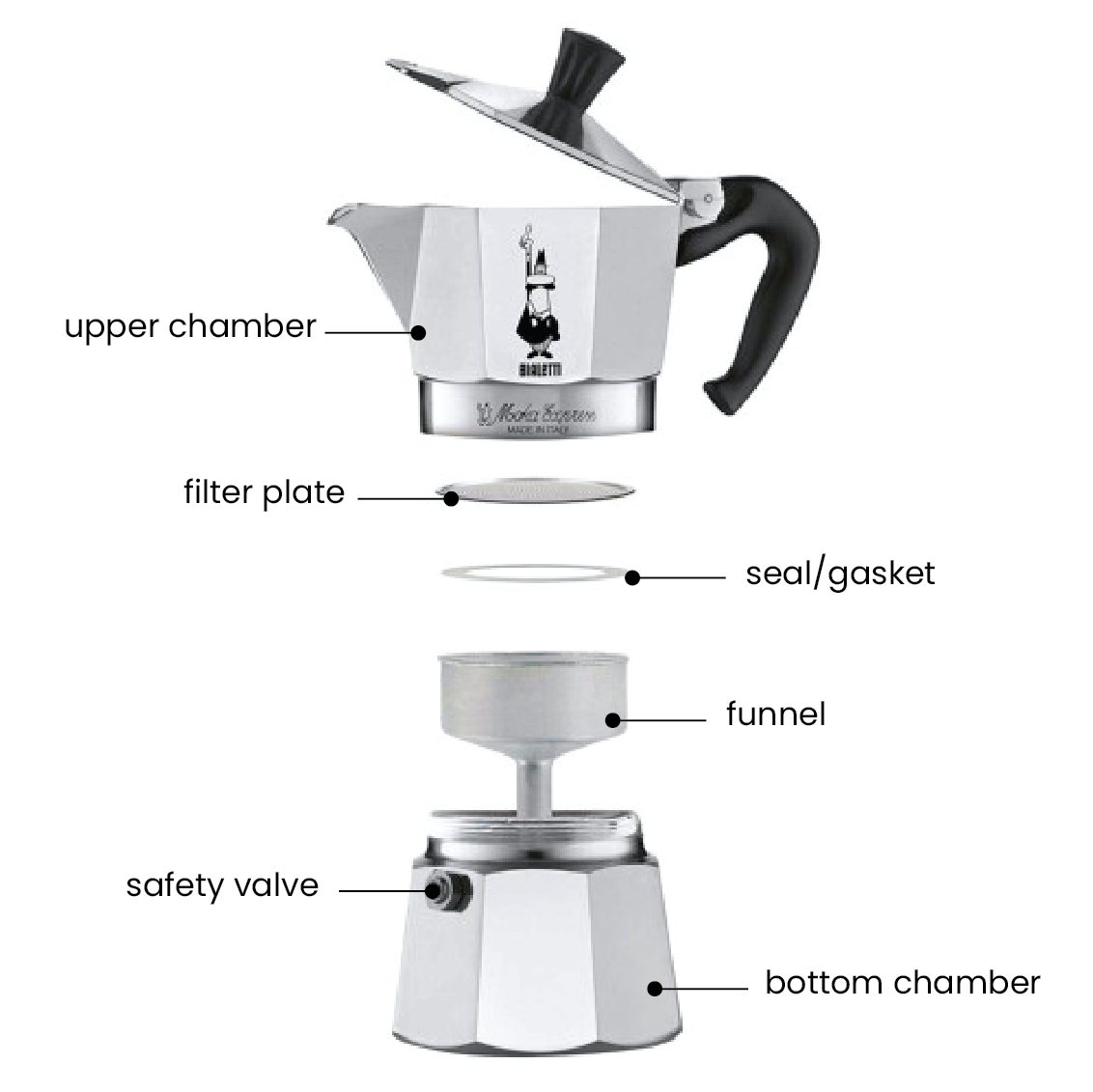The History
The stovetop brewer was invented in Italy by Luigi Di Ponti who sold his design to aluminium vendor and engineer, Alfonso Bialetti. The 'Moka Express' made its debut in 1933 and slowly became a staple in Italian households. Espresso machines at the time were bulky and very costly making the invention of the stovetop brewer a revolutionary leap in making coffee (particularly espresso) widely accessible to the average person.
Today, Bialetti is the number one producer of stovetop brewers, collaborating with artists and brands to create unique and beautiful designs.

How it Works
When brewing with a stovetop, water is placed in the bottom chamber, coffee in the funnel and the upper chamber is tightly screwed on to the bottom.
As the water heats up, steam starts to fill the bottom chamber and with nowhere to go, this creates enough pressure to push the water up through the funnel, through the coffee and the resulting espresso collects in the upper chamber.
Best Practice for Stovetop Brewers
-
Click here for Cleaning & Sanitation Products
When filling the bottom chamber with water, stop just below the safety valve. The valve is an important feature and as its name suggests, is there for your safety. Covering the valve will result in it not working properly which could potentially be dangerous if not addressed.
Use filtered water where possible to prevent mineral and scale from forming around the valve. There are cleaning chemicals specifically made for brewers but white vinegar works too.
-
Click here to view Airscape Bean Storage
Unlike espresso machines, the coffee in a stovetop brewer does not need to be fine or to be tamped down.
When brewing with a stovetop, use a medium-fine grind. Freshly ground coffee is always best but if you don't have a grinder, we're happy to pre-grind the coffee for you. Make sure to keep your coffee in an airtight container away from light and moisture.
-
If your brewer is brand new, it may take several brews to soften the gasket. Make sure to wash your stovetop brewer with hot water and a soft sponge. The dishwasher is not suitable to clean most stovetop brewers, especially ones made with aluminium. We don't recommend using soap or chemicals in your brewer unless absolutely necessary such as if the filter plate is clogged or if you need to use a descaling chemical to remove limescale.
Click on the problem that applies to your brewer. if none of the following apply to you, contact us! All Bialetti products have a two year manufacturer's warranty. if you bought your brewer from us, bring it over to the roastery with your receipt and we'll go from there.
What Seems to be the Problem?
Whistling/hissing noise and steam coming out of the safety valve
The safety valve is a very important feature in any stovetop brewer. Its purpose is to release steam once a certain level pressure is reached.
There are several ways to fix this -
The Valve
- Fill the chamber with water up to just below the valve. If the valve is covered, it won't function properly and create too much pressure in the pot which could potentially be dangerous.
Do not, under any circumstances, attempt to disassemble the valve. - The valve could also be obstructed by a build up of limescale and mineral. To prevent this, use filtered water.
If there is scale buildup, the valve has a piston on the inside of the bottom chamber. Place your finger on the piston and slowly move it in a circular motion to loosen any stuck debris.
The Grind Size
- Make sure your grind is appropriate for your brewer. If the grind is too fine or tamped down, it prevents the water from passing through the ground coffee which creates extra pressure to compensate. We recommend a medium-coarse grind for a stovetop. If you're not sure, give us a ring or a visit at the roastery.
The Filter Plate
- The filter plate could be blocked by ground coffee. Give it a good rinse with soap and water
Water sputtering out between upper and bottom chambers
Firstly, make sure the top and bottom chambers of your brewer are tightly secured.
Note that if you have a brand new brewer, sometimes it takes several brews before the gasket softens enough to create the necessary seal.
If your brewer is not brand new, it could be time for you to change the gasket and filter.
Click here for a replacement gasket and filter set.
Brewing too slowly
If you have an induction stove, you may need an induction plate.
Click here to view Induction Plate.
The heat used should be medium to medium high. If you're using a gas stove make sure the flame is contained to the size of the bottom chamber to prevent the handle from getting hot.
The grind size might also be too fine, making it harder for the water to pass through the coffee grounds. Adjust your grind size coarser or ask your local roastery (preferably us 😉) to grind your beans for you.
There could also be a blockage somewhere, to fix this, disassemble your brewer and wash out all the components with a soft sponge and hot water. Do not use soap unless absolutely necessary. If using soap, make sure to rinse it thoroughly.
Brewing too fast
This could be because your grind size is too coarse, resulting in an under-extracted espresso.
Adjust your grind size finer to create the pressure needed for a good extraction.
Alternatively, it could be that the upper and bottom chambers are not tightly sealed together.
If it's tightly sealed and it's still brewing too fast, you may need a new gasket.
Click here to view the seal/filter pack
